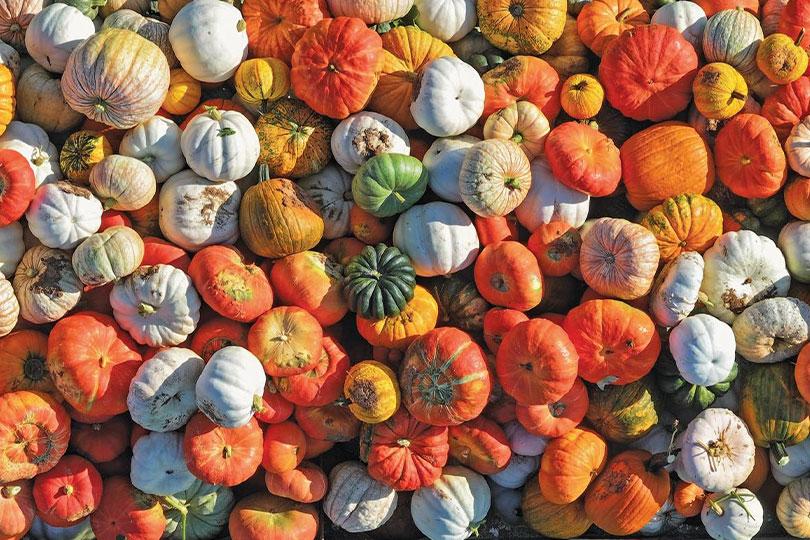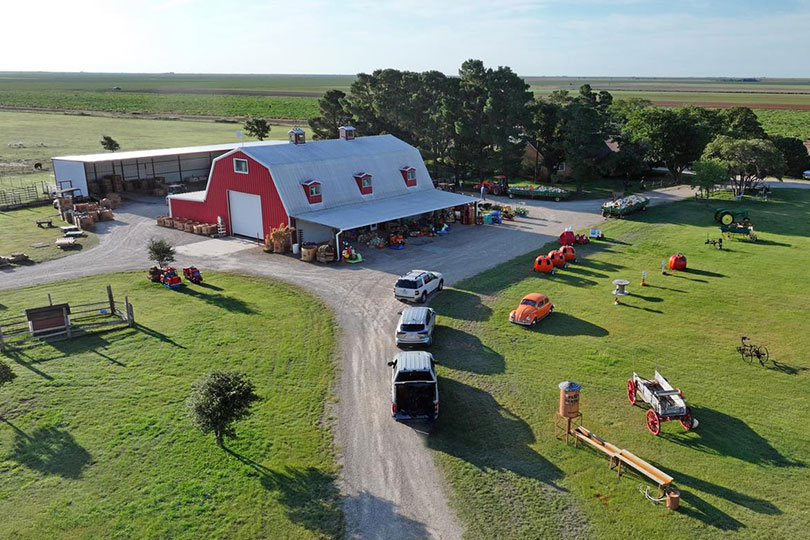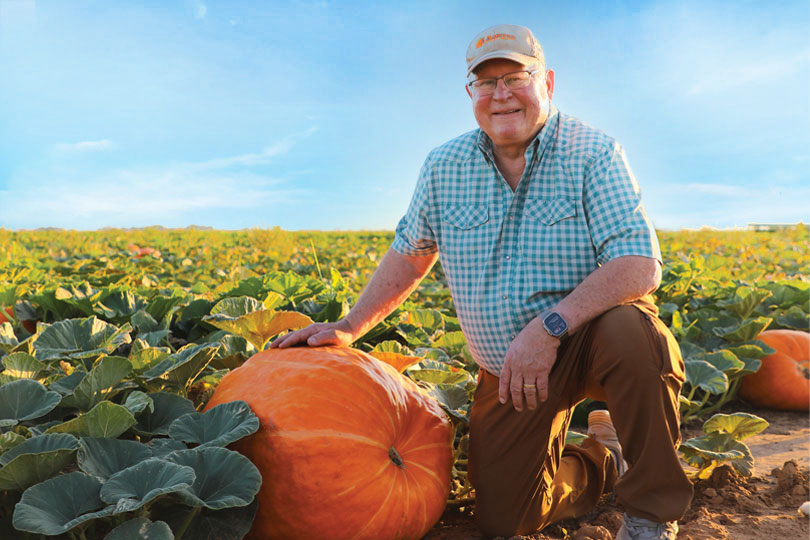By Shelby Shank
Field Editor
By the time autumn settles across the High Plains, fields in Floydada are dotted with orange, white and multicolored pumpkins of every size.
Tim Assiter, owner of Assiter Punkin’ Ranch, has carried on the family tradition of growing pumpkins that began more than 60 years ago when B.A. “Slim” Robertson planted the seeds of what would become the family’s pumpkin legacy.
Assiter’s father joined Slim in the 1960s, selling wholesale pumpkins. It wasn’t until the early 1990s when Assiter came back to the farm that they began carving out a bigger role in retail sales.
“In about 1992, we started trying to do a little bit of retail selling,” he said. “We built the iconic red barn were known for in the 2000s.”
Today, the farm balances wholesale with agritourism. Families, school tours and nursing home groups visit each fall to explore the fields, learn about pumpkins and enjoy seasonal activities.
And pumpkins have been a part of Floydada’s history for centuries.
“Pumpkins were first discovered in this area in 1541 when Francisco Vázquez de Coronado, a Spanish conquistador and explorer came through the Texas Panhandle,” Assiter said. “Pumpkins are kind of indigenous to here, and we have some great growers in Floydada. That’s why we’re Pumpkin Capital USA.”
The region’s low humidity, soil and controlled irrigation make it an ideal place to grow pumpkins. And for Assiter, that includes more than 200 varieties.
“Even within the traditional orange Jack-O’-Lantern pumpkins, there are 40 to 50 varieties,” he said. “Some small, some large, some squatty and some tall.”
Customers visiting the farm can find pumpkins in every shape, size and color, from basketball-sized gourds to unusual varieties rarely seen in grocery stores.

Among Assiter’s favorites are the massive Prizewinner pumpkins and the “One Too Many,” a white pumpkin laced with pink and green veins.
“My dad was an expert at growing the Prizewinner pumpkin,” Assiter said. “That’s the biggest pumpkin we grow here, and some of those grow as big as 250 pounds.”
The pumpkins don’t just stay local either. Shipments go north to Oklahoma and Arkansas, east to Louisiana and across much of Texas.
“We don’t ship much west because they grow pumpkins in New Mexico and Arizona,” Assiter said. “They have less humidity. If you go east of Abilene, pumpkins tend not to grow as well, and that has a lot to do with the heat and humidity.”
Despite limited rainfall, the area’s dry climate gives Floydada farmers a distinct advantage.
“Pumpkins will do well in almost any kind of soil as long as they’re properly maintained and cared for,” he said.
Today, Assiter grows about 40 acres of pumpkins, aiming for roughly 40,000 pounds per acre.
“It’s hard to say how many pumpkins we grow each year because our smallest fits in the palm of your hand, while the largest weigh a couple hundred pounds,” he said. “We try to raise as many pounds to the acre, so if you try to figure that our per acre, that’s a lot of pumpkins!”
The work begins almost as soon as the season ends. After harvest, fields are plowed, fertilized and prepared. Seeds are ordered in December, then planted in May and June. By September, harvest is in full swing, with every pumpkin being cut, picked and boxed by hand.
“To test when a pumpkin is ready, we do a simple skin test,” Assiter said. “If you can press your fingernail into the pumpkin’s skin, it’s not ready. Once the skin is hard enough, we know it’s time to harvest and start picking.”
Wholesale pumpkins are packed into four-foot square bins, each holding 40 to 60 large pumpkins.

Unlike grocery stores, where bins are uniform, Assiter’s bins are mixed with a variety of different shapes and colors of pumpkins.
“We specialize in mixing bins with different varieties of pumpkins, which is a lot different than what most growers typically do,” he said.
That variety has made the farm popular with porch decorators, who create elaborate fall displays.
“It takes about half a bin to decorate a small porch,” Assiter said. “They deliver, stage and even pick up the pumpkins at the end of the season. Porch decorators have become a big influence.”
The trend reflects broader changes in the industry.
“It used to be that 60% of what we sold were Jack-O’-Lanterns, but today porch decorators and customers want more variety,” Assiter said. “Now it’s about color, oddities and diversity, not just a pumpkin to carve in October.”
After years as an auctioneer, Assiter returned to the farm to help his parents and carry on the fall tradition.
“I always thought I was born in a pumpkin patch, and I tease about that a lot, too,” he said. “But this is where my roots are.”
His children remain involved, too, including a daughter who now runs her own porch decorating business.
“There’s a lot of tradition in growing pumpkins here, and I want to keep it going as long as I can,” Assiter said. “Nearly all the big pumpkin farms have been family operations. It’s hard work, but it’s part of who we are.”
Pumpkin farming in Floydada once numbered 30 growers working 3,000 acres. Today, only five growers remain, managing about half that acreage.
“I think we grow about as many pumpkins as we did back in the day, but we’ve increased our efficiency, our water systems and our varieties,” Assiter said.
The true reward, however, comes from the people who visit.
“What makes me happiest is seeing kids leave with a pumpkin and a big grin. Whether they’re carving it, decorating it or even selling it, that’s the part that makes this work so rewarding,” he said.


Leave A Comment